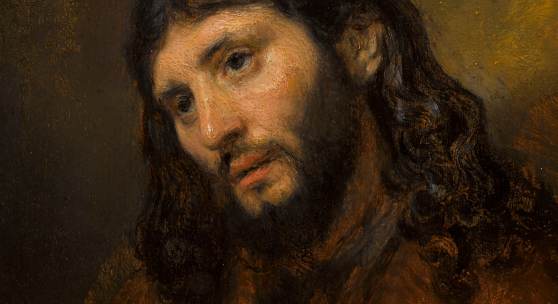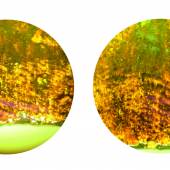Rembrandt's fingerprints found on rare oil sketch
-
Auktion05.12.2018
LONDON, 21 November 2018: Buried in the original layer of paint in the lower edge of the 17th-century oil sketch are two fingerprints - presumably those of the painting's creator - Rembrandt van Rijn. Pressed into wet paint, the prints, which are most certainly impressions of the artist’s thumb, had been hidden underneath overpaint and darkened varnish layers and were only recently discovered during technical examination and restoration. The distinguishing marks, while difficult to prove conclusively, are believed to be the only known fingerprints of the Dutch master. A highlight of Sotheby’s Old Masters Evening Sale on 5 December, Study of a Head of a Young Man, a little-known masterpiece, will be offered with an estimate in the region of £6 million. A touching portrayal of Christ, the work until recently hung in the artist’s house in Amsterdam and comes to the market for the first time in 60 years.
In preparation for its display as part of the seminal exhibition Rembrandt and the Face of Jesus (the Louvre, Paris; the Philadelphia Museum of Art and the Detroit Institute of Arts, 2011-2012), the painting underwent extensive examination using pigment analyses, dendrochronology, x-ray and infra-red imagining. Conducted by Dr Arie Wallert and Michel van de Laar, scientific researcher and conservator, both formerly of the Rijksmuseum, the investigations revealed, among other crucial facets of the painting that securely positioned the work in Rembrandt's oeuvre, two fingerprints on the bottom edge of the painting.
George Gordon, Worldwide Co-Chairman of Sotheby’s Old Master Paintings said: “While as far as we know no comparable finger- or thumb- prints of Rembrandt have been found in other works in order to confirm the conclusion, the discovery of the marks in the original layer of paint along the lower edge make their connection to the artist highly credible.
As the foremost master of the Western artistic tradition, Rembrandt is an artist who draws great interest from collectors around the world, so for a rare sketch such as this to be personalised in such a way, makes the painting all the more interesting.”
Speaking of the discovery, Michel van de Laar, Conservator, Amsterdam, said: “As in other colour sketches by the artist, the work was also determined to have been executed in one sitting - a practice known at the time as ten eersten opmaken - 'to complete the whole concept in one go', where additional colours and layers are hastily applied, even before the underlay has a chance to dry. Prone to smudging, the technique could only be accomplished by the most skilled of painters. An under laying sketch in brown is locally left exposed and is finished only with a very simple pallet. Changes and retouches of the artist are recognizable yet give a certain dynamic. The discovery of the fingerprints, is further testament to the speed with which the work was likely executed and provides fresh insight into Rembrandt's complex but swift painting technique.”
Revered among the great masters of the Dutch Golden Age, Rembrandt was a prolific painter, draughtsman and etcher whose ingenuity inspired some of the most celebrated European artists of the 17th to the 19th centuries. Highly coveted, many of his masterpieces form the highlights of some of the greatest private and public art collections in the world, with paintings, particularly of this quality and condition, rarely coming to the open market.
Speaking of the painting, Gordon added: “While Rembrandt mastered a range of styles and subject matter from genre paintings and landscapes to religious works, he is most celebrated for his studies of the human image. Admired for their emotional and psychological intensity and combined with a deeply personal understanding of light, space and atmosphere, these studies, whether of himself or of others, exemplify Rembrandt’s exceptional painterly ability and his intense preoccupation with direct observation and the study of people.”
Dating from around 1650, Study of the Head of a Young Man, measuring just over ten inches, is one of a small series of informal but intensely moving oil sketches painted by Rembrandt of the same young man, from the neighbourhood in Amsterdam where the artist lived. As in others from the series, of which the best known is one in the Gemäldegalerie in Berlin, Rembrandt envisions his model as Jesus Christ, seen here with his hands clasped in prayer. Imparting the basic kindness and refined human nature of Christ, not as a deity but as a man, this powerful and touching portrait was one of seven oil sketches of the Head of Christ featured in the exhibition Rembrandt and the Face of Jesus for which the painting underwent examination. More recently, it hung on loan in the Museum Het Rembrandthuis in Amsterdam – Rembrandt’s home – in the room near his studio where he slept, where in his inventory drawn up a few years later in 1656 are recorded two “tronies” (studies) of Christ by Rembrandt, one of which is most likely this oil sketch.
-
14.03.2015 - 22.03.2015Von 14. bis 22. März 2015 lädt der Verband Österreichischer Antiquitäten- und Kunsthändler wieder...
-
St. Petersburg's most popular visitor attraction, and one of the world's largest and most...
-
Doch bald trifft Rembrandt ein schwerer Verlust. Saskia, die nach der Geburt des Sohnes Titus...
-
20.04.2024 - 24.11.2024Jeffrey Gibson on Representing the United States and Himself By Melissa Smith | Feb 16, 2024 From...
-
13.05.2024 - 15.05.2024Sotheby’s Sealed is thrilled to present this spectacular Mercedes-Benz 300 SL Alloy...
-
14.05.2024Warhol & Basquiat’s Collaboration Series Masterwork To Highlight Sotheby’s...
-
05.12.2018Auktion »
.
















